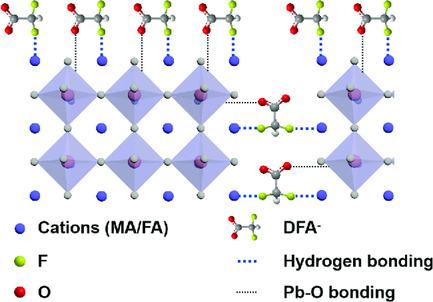Our official English website, www.x-mol.net, welcomes your
feedback! (Note: you will need to create a separate account there.)
Efficient and Stable Perovskite Solar Cells by Fluorinated Ionic Liquid–Induced Component Interaction
Solar RRL ( IF 6.0 ) Pub Date : 2020-11-14 , DOI: 10.1002/solr.202000582 Yue Wang 1 , Lingfeng Chao 1 , Tingting Niu 1 , Deli Li 1 , Qi Wei 2 , Hui Wu 1 , Jian Qiu 3 , Hui Lu 3 , Chenxin Ran 1 , Qi Zhong 4 , Lin Song 1 , Guichuan Xing 2 , Yingdong Xia 3 , Yonghua Chen 1, 3 , Peter Müller‐Buschbaum 5, 6 , Wei Huang 1, 3, 7
Solar RRL ( IF 6.0 ) Pub Date : 2020-11-14 , DOI: 10.1002/solr.202000582 Yue Wang 1 , Lingfeng Chao 1 , Tingting Niu 1 , Deli Li 1 , Qi Wei 2 , Hui Wu 1 , Jian Qiu 3 , Hui Lu 3 , Chenxin Ran 1 , Qi Zhong 4 , Lin Song 1 , Guichuan Xing 2 , Yingdong Xia 3 , Yonghua Chen 1, 3 , Peter Müller‐Buschbaum 5, 6 , Wei Huang 1, 3, 7
Affiliation

|
The instability of organic cations in lead halide perovskite materials is a major obstacle for the commercial breakthrough of perovskite photovoltaics due to desorption of organic cations during the thermal annealing and device operation. Herein, a novel strategy is reported to improve the performance and stability of organic halide perovskite solar cells containing organic cations by adding a small amount of the ionic liquid methylammonium difluoroacetate (MA+DFA−). Nuclear magnetic resonance and Fourier‐transform infrared spectroscopy measurements show that MA+DFA− can anchor the organic cations via hydrogen bonding and enhance the Pb–O interaction in perovskite precursors, leading to the retardation of the perovskite crystallization and improved stability of the perovskite precursor solution. Dynamic light scattering and scanning electron microscopy verify the defect‐passivation effect of MA+DFA− on the perovskite precursors and films. The passivated perovskite film shows superior photo carrier dynamics as investigated by time‐resolved photoluminescence and transient absorption spectra. Moreover, the hydrogen bonding of the perovskite with MA+DFA− imparts excellent ambient and thermal stability to the film as revealed by X‐ray diffraction measurements. As a result, devices with a high efficiency of 21.46% and excellent stability over 180 days in nitrogen atmosphere at room temperature are achieved with the ionic liquid.
中文翻译:

氟化离子液体诱导的组分相互作用产生高效,稳定的钙钛矿太阳能电池
卤化钙钛矿材料中有机阳离子的不稳定性是钙钛矿光伏技术商业突破的主要障碍,这是由于在热退火和器件操作过程中有机阳离子的解吸。在本文中,一种新的战略报道通过将离子液体甲基铵二氟(MA少量改善有机卤化物含有钙钛矿有机阳离子太阳能电池的性能和稳定性+ DFA - )。核磁共振和傅里叶变换红外光谱仪测量结果表明,MA + DFA -可以通过氢键锚定有机阳离子并增强钙钛矿前体中的Pb-O相互作用,从而导致钙钛矿前体结晶的延迟和钙钛矿前体溶液的稳定性提高。动态光散射和扫描电子显微镜验证MA的缺陷的钝化效果+ DFA -对钙钛矿前体和薄膜。经时间分辨的光致发光和瞬态吸收光谱研究,钝化的钙钛矿膜显示出优异的光载流子动力学。此外,利用MA钙钛矿的氢键+ DFA -X射线衍射测量表明,该薄膜具有出色的环境和热稳定性。结果,使用该离子液体获得了具有21.46%的高效率和在室温下在氮气氛中在180天内优异的稳定性的器件。
更新日期:2021-01-07
中文翻译:

氟化离子液体诱导的组分相互作用产生高效,稳定的钙钛矿太阳能电池
卤化钙钛矿材料中有机阳离子的不稳定性是钙钛矿光伏技术商业突破的主要障碍,这是由于在热退火和器件操作过程中有机阳离子的解吸。在本文中,一种新的战略报道通过将离子液体甲基铵二氟(MA少量改善有机卤化物含有钙钛矿有机阳离子太阳能电池的性能和稳定性+ DFA - )。核磁共振和傅里叶变换红外光谱仪测量结果表明,MA + DFA -可以通过氢键锚定有机阳离子并增强钙钛矿前体中的Pb-O相互作用,从而导致钙钛矿前体结晶的延迟和钙钛矿前体溶液的稳定性提高。动态光散射和扫描电子显微镜验证MA的缺陷的钝化效果+ DFA -对钙钛矿前体和薄膜。经时间分辨的光致发光和瞬态吸收光谱研究,钝化的钙钛矿膜显示出优异的光载流子动力学。此外,利用MA钙钛矿的氢键+ DFA -X射线衍射测量表明,该薄膜具有出色的环境和热稳定性。结果,使用该离子液体获得了具有21.46%的高效率和在室温下在氮气氛中在180天内优异的稳定性的器件。











































 京公网安备 11010802027423号
京公网安备 11010802027423号